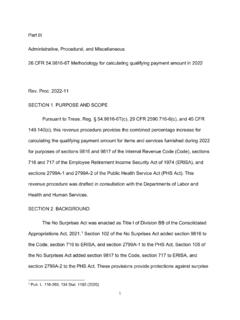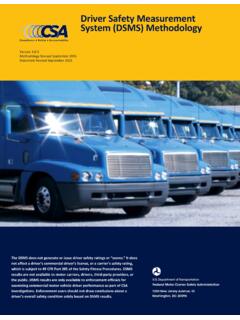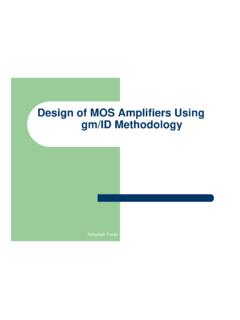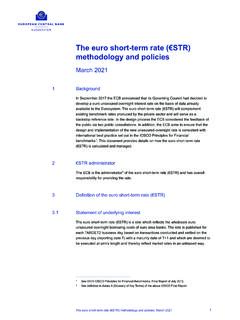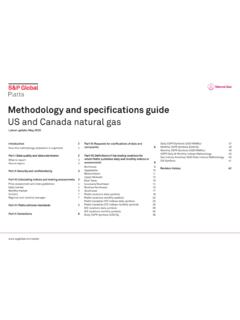Transcription of Qualifying Payment Amount Calculation Methodology
1 Qualifying Payment Amount Calculation Methodology45 CFR 2021 Disclaimers and Notifications The information provided in this presentation is intended only to be a general informal summary of technical legal standards. It is not intended to take the place of the statutes, regulations, or formal policy guidance upon which it is based. This presentation summarizes current policy and operations as of the date it was presented. We encourage readers to refer to the applicable statutes, regulations, and other interpretive materials for complete and current information. The contents of this document do not have the force and effect of law and are not meant to bind the public in any way, unless specifically incorporated into a document is intended only to provide clarity to the public regarding existing requirements under the law.
2 This communication was printed, published, or produced and disseminated at taxpayer The Qualifying Payment Amount (QPA) is the basis for determining individual cost sharing for items and services covered by the balance-billing protections in the No Surprises Act (NSA), under certain for emergency items and services and non-emergency items and services furnished by an out-of-network provider in an in-network facility must be based on the lesser of billed charges or the QPA, where an All-Payer Model Agreement under section 1115A of the Soc. Sec. Act or a specified state law does not for air ambulances services must be based on the lesser of billed charges or the QPA Certified Independent Dispute Resolution (IDR)
3 Entities are required to consider the QPA when selecting between the offer submitted by a plan or issuer and the offer submitted by a facility or provider or provider of air ambulance services when determining the total out-of-network Payment rate for items and services subject to the federal IDR DefinedThe QPA for a given item or service is generally the median contracted rate on January 31, 2019 for the same or similar item or service, increased for inflationMedian Contracted RateThe median contracted rate for an item or service is determined by: Identifying the contracted ratesof all plans of the plan sponsor (or of the administering entity, if applicable) or all coverage offered by the issuer in the same insurance marketfor the same or similar item or servicethat is provided by a provider in the same or similar specialtyor facility of the same or similar facility typeand provided in the geographic regionin which the item or service is furnished.
4 Arranging the contracted rates from least to greatest, and selecting the middle number (or the average of the middle two numbers, if there are an even number of contracted rates). Contracted Rate Defined The contracted rate is the total Amount (including cost sharing) that a group health plan or health insurance issuer has contractually agreed to pay a participating provider, facility, or provider of air ambulanc e services for covered items and services, whether directly or indirectly, including through a third-party administrator (TPA) or pharmacy benefit manager (PBM).Contracted Rate Rules & Exclusions The Amount negotiated under each contract is treated as a separate rates paid under single case agreements, letters of agreement, or similar arrangements between a provider, facility, or provider of air ambulance services and a plan or issuer, used to supplement the network of the plan for a specific enrollee, participant, or beneficiary in unique circumstances.
5 The rate negotiated under a contract constitutes a single contracted rate regardless of the number of claims paid at that contracted Rate Other Rules If a plan or issuer has:oseparate contracts with individual providers rate under each contract constitutes a single contracted rate (even if the same rate is paid to other providers under separate contracts).oa single contract with a provider group or facility, with the same negotiated rate applying to all providers in the group/facility rate negotiated with that provider group or facility is treated as a single contracted single contract with multiple providers, with separate negotiated rates with each particular provider each unique contracted rate constitutes a single contracted rate for purposes of determining the median contracted rate.
6 Same Insurance Market Insurance market is defined as: oIndividual market (excludes short-term, limited-duration insurance).oSmall group group market. For self-insured group health plans, insurance market means: oall self-insured group health plans (other than account-based plans and plans that consist solely of excepted benefits) of the plan sponsor, or oat the option of the plan sponsor, all self-insured group health plans administered by the same entity (including a TPA contracted by the plan) that s responsible for calculating the QPA on behalf of the plan. Any plan or coverage that is not a group health plan or group or individual health insurance coverage offered by a health insurance issuer, as those terms are defined in the Code, ERISA, and the PHS Act, such as a Medicare Advantage or Medicaid managed care organization plan, must also not be included in any insurance market for purposes of determining the QPA.
7 Relevant market is determined irrespective of the state. All markets exclude coverage that consists solely of excepted benefits Same or Similar Item or Service Defined as a health care item or service billed under the same service code, or a comparable code under a different procedural code system. Service code:the code that describes an item or service, including a Current Procedural Terminology (CPT), Healthcare Common Procedure Coding System (HCPCS), or Diagnosis-Related Group (DRG) code. Same or Similar Item or Service Modifiers Modifiers: codes that are applied to the service code to provide a more specific description of the furnished item or service and that may adjust the Payment rate or affect the processing or Payment of the code billed.
8 Median contracted rates must be calculated separately for CPT code modifiers that distinguish the professional services component ( 26 ) from the technical component ( TC ). If application of a modifier causes contracted rates to vary, the plan or issuer must calculate a separate median contracted rate for each such service code-modifier combination. Modifiers that don t cause contracted rates to vary must not be taken into account when calculating the median contracted rate. Provider in the Same or Similar Specialty Defined as the practice specialty of a provider, as identified by the plan or issuer consistent with the plan s or issuer s usual business practice.
9 W ith respect to air ambulanc e services, all providers of air ambulanc e services are considered to be a single provider specialty. If a plan or issuer has contracted rates for a service code that vary based on provider specialty, the median contracted rate is calculated separately for each provider specialty. Facility of the Same or Similar Facility Type Defined to mean, with respect to emergency services, either an emergency department (ED) of a hospital or an independent freestanding emergency department (IFED). If a plan s or issuer s contracted rates for emergency services vary based on the type of facility (that is, whether a facility is a hospital ED or an IFED, the median contracted rate is calculated separately for each facility type.)
10 Note:Plans and issuers may not separately calculate a median contracted rate based on other characteristics of facilitiesthat might cause contracted rates to vary, such as whether a hospital is an academic medical center or teaching RegionNon-air ambulance items and servicesAir ambulance servicesPrimary definitionOne region for each MSA in the stateOne region consisting of all other portions of the stateOne region consisting of all MSAs in the state One region consisting of all other portions of the stateFirst alternativeOne region consisting of all MSAs in the stateOne region consisting of all other portions of the stateOne region consisting of all MSAs in the Census divisionOne region consisting of all other portions of Census divisionSecond alternativeOne region consisting of all










